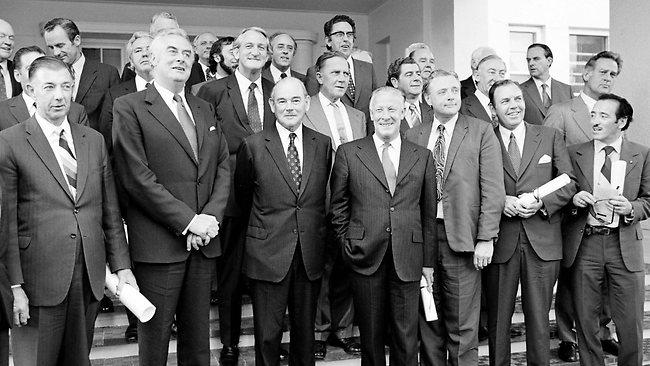Whitlam's whirlwind leadership
FROM health and education to foreign policy and law, Gough's legacy endures.

FOR Gough Whitlam, winning an election mandate was not viewed "merely as a permit to preside but as a command to perform". On December 2, 1972, Whitlam wasted no time in using the authority of Labor's election victory to dramatically reshape Australia.
After a euphoric election-night party at his home in Cabramatta, Whitlam was up early the next morning to begin a transition to government. He spoke to the defeated prime minister Billy McMahon by phone. By Sunday afternoon, Whitlam's VIP jet had touched down at Canberra's Fairbairn airport. Later, he met with senior public servants to begin forming a new government.
Just after 3.30pm on Tuesday, December 5, three days after the election, Whitlam and his deputy Lance Barnard were sworn in as a duumvirate government, holding 27 portfolios between them. Whitlam held 13 portfolios and Barnard held 14. Nobody could accuse Whitlam of being domineering.
It would be a further two weeks before the full ministry was sworn-in by the governor-general, Sir Paul Hasluck, on December 19. By then, Whitlam said the duumvirate was more accurately a "triumvirate", with Hasluck as the third member, responsible for some of the most significant decisions of any government in Australian history. The first, announced minutes after Whitlam and Barnard were sworn in, was the abolition of conscription. A further 40 or so major decisions were made during the duumvirate's 14-day rule.
They included completing the withdrawal of troops from Vietnam, freeing conscientious objectors to the war and banning racially selected sporting teams from touring Australia. The ban on advertising contraceptives was removed, sales tax on the pill was abolished and the imperial honours system was scrapped. Talks on independence for Papua New Guinea and diplomatic recognition of China commenced.
Grants were made, formal inquiries were announced, committees and commissions were convened, ambassadors were recalled and treaties were signed. Departments were abolished and others were established. "Nugget" Coombs was announced as a special adviser to the government, and Elizabeth Evatt was appointed to the Conciliation and Arbitration Commission.
One journalist called it "rapid-decision government". The public service couldn't keep up. Cabinet secretary John Bunting suggested to his deputy: "It would be useful to get from the press or the prime minister's office the daily statement of decisions or actions."
Whitlam did not want to wait until the full ministry was appointed. It had to be elected by the Labor caucus, which would not happen for nearly two weeks. To delay until then, a week before Christmas, would risk losing the "momentum". As Whitlam said, he had a command to perform.
The earliest days of the government illustrate one of Whitlam's enduring legacies: leadership. Whitlam was a conviction politician. He was in politics for a purpose. He was a change agent. His mission was to reform Australia. He pursued it relentlessly with vision, intellect and courage.
It underscored Whitlam's inimitable description of himself as a "crash through or crash politician". This virtue, however, was also a vice. The drive to implement his mandate, at almost any cost, led to a chaotic and, at times, shambolic government that paid little attention to the economy, the state of the budget or public opinion.
It had been Whitlam's style since he wrested the leadership from Arthur Calwell in the wake of Labor's disastrous 1966 election campaign. Whitlam knew Labor needed to reform its internal structures and renovate policies. Calwell was an obstacle to reform.
Whitlam made the case for reform to hostile party audiences and challenged the power of the faction bosses. In April 1968, after a clash with the federal executive, he abruptly resigned and asked the parliamentary party to reaffirm his leadership. He was challenged by Jim Cairns but narrowly won the ballot by 38 to 32 votes.
His reforms to the party's internal structures and policies were achieved over many years at many party conferences and committee meetings. They were the result of painstaking consultation, research and advocacy.
When he delivered the "It's Time" speech, which catapulted Labor to government, he could declare that it was the most thoroughly developed manifesto ever presented to the people. It reflected Whitlam's personal experience of inequality in health, education and community services living in the outer Sydney suburbs of Cronulla and Cabramatta.
Having won a mandate, Whitlam was determined to implement it even if it meant putting his government on the line. By mid-1974, legislation was being blocked in the Senate. Whitlam decided to seek a refreshment of his mandate at a double-dissolution election. If successful, it could enable the passage of blocked legislation at a joint sitting of parliament.
This was leadership in action. It was also risky. The government's popularity had faded. No Labor leader had ever won back-to-back elections. But Whitlam went to an election, arguing the case for six bills, including "one-vote, one-value" electoral laws and universal healthcare Medibank and his government was returned. At the first-ever joint sitting of parliament, the legislation was passed. But Senate obstruction remained. The denial of legitimacy, as Whitlam termed it, continued. It would lead to the dismissal of the government on November 11, 1975. But the legacy of leadership and the landmark reforms remain.
Recently, the Institute of Public Affairs, once the wellspring of philosophy for the embryonic Liberal Party in the 1940s, urged Tony Abbott to "be like Gough". Their argument was that Whitlam had secured his place in history because he had enacted an ambitious reform agenda. Almost all of the Whitlam reforms remain to this day, from health and education policy to law reform and foreign policy. The IPA may not agree with all of it, but they paid tribute to Whitlam's boldness.
It is a fitting recognition from the heirs to the conservative establishment that worked to destroy the Labor government of 1972 to 1975 that Whitlam's life was, more than anything else, the very personification of leadership in politics.




